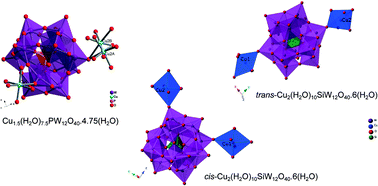Disorder and Polymorphism is Cu (II)-polyoxometalate complexes:[Cu1.5(H2O)7.5PW12O40]4.75H2O, cis- & trans-[Cu2(H2O)10SiW12O40]6H2O
슈퍼관리자
2021-05-21
Disorder and Polymorphism is Cu (II)-polyoxometalate complexes:[Cu1.5(H2O)7.5PW12O40]4.75H2O, cis- & trans-[Cu2(H2O)10SiW12O40]6H2O
-
Authors :
Sneha Rohita Bajpe, Sebastian Henke, Jung-Hoon Lee, Paul Bristowe, and Anthony K. Cheetham
-
Journal :
CrystEngComm
-
Vol :
18
-
Page :
5327
-
Year :
2016

Abstract
AbstractThree highly crystalline Cu(II)-polyoxometalate (POM) complexes, [Cu1.5(H2O)7.5PW12O40]·4.75H2O and cis- and trans-[Cu2(H2O)10SiW12O40]·6H2O, were successfully synthesized and characterized by single crystal and powder X-ray diffraction as well as thermogravimetric analysis. All complexes feature octahedrally coordinated, Jahn–Teller-distorted CuII centres, which are coordinated by one terminal oxygen atom of the POM anion and five water molecules. The crystal structure of [Cu1.5(H2O)7.5PW12O40]·4.75H2O, reveals four-fold disorder at one of the two Cu-sites, whereas [Cu2(H2O)10SiW12O40]·6H2O crystallizes in two fully-ordered polymorphic forms: a monoclinic structure containing an angled cis configuration of the Cu-POM-Cu molecule and a triclinic structure containing a linear trans configuration. Density functional theory (DFT) calculations show that the cis polymorph of [Cu2(H2O)10SiW12O40]·6H2O is more stable than the trans form by about 30 kJ mol−1.
















